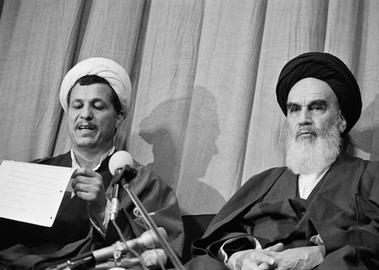The following article was written by an Iranian citizen journalist on the ground inside the country, who writes under a pseudonym to protect his identity.
“Our message is clear: House arrests must end.”
That’s the chant that could be heard just as the voice of Iran’s supreme leader came out the loudspeakers, asking for God’s mercy.
At 10am on Tuesday, January 10, Revolution Avenue and the streets leading to Tehran University were packed with crowds. People had traveled from across Tehran and Iran to join the funeral procession of Akbar Hashemi Rafsanjani — a political figure whose sudden death has shocked his friends and foes alike, and whose political intelligence and conduct after the 2009 presidential election led to thousands of people wanting to pay their respects.
But many people had also come to show their support for the Green Movement and its leaders, who have now been living under house arrest for years.
The streets leading to Revolution Square were closed from dawn. Everybody waited for the ceremony, which was due to commence at 8:30 at the same location where, in 2009, Rafsanjani delivered his last prayers as Tehran’s Friday prayers leader. The support he gave for the Green Movement that day is still remembered — as is what followed: censorship of Rafsanjani’s speech on television and on his website, and Rafsanjani being removed from his long-held post.
Today’s rush of people from early on delayed the arrival of Rafsanjani’s body and the mourning ceremonies. The metro station at Revolution Square was closed at 9am due to the high volume of passengers, who were told that they had to get off at stations well before their planned destination. The same happened with the buses that Tehran’s Municipality provided to help manage crowds. Passengers had to get off and walk the rest of way.
Policemen, Guns and Surveillance Cameras
Police were everywhere: On the rooftops of many buildings, tall and short. Plainclothes agents and anti-riot police were stationed for surveillance; many people used the vantage point of the rooftops to film the crowds — in addition to the many cameras, both hidden and visible, which had been installed on buildings over the last two days.
Most of the buildings along Revolution Avenue were evacuated in order to station police and plainclothes agents. Some of them had no qualms about showing off the guns hidden under their jackets.
The streets around Tehran University, Quds and Azar —about 16 streets in all — overflowed with crowds. Everyone’s destination was the same: Revolution Avenue. When the Prayer for the Dead was recited, little by little the chants started. The first that one we could hear was: “O, Hossein, Mir Hossein,” a play on the name of the sacred Shia Imam Hossein ibn Ali and the first name of Mir Hossein Mousavi, one of the Green Movement leaders under house arrest. The chants started just as “O, Hossein!” could be heard coming out of government-provided loudspeakers.
People carried handwritten and typed signs, and some held up photos of Hashemi Rafsanjani and President Rouhani. One group walking right in the middle of Revolution Avenue started chanting: “Loudspeakers are yours; the voice of justice is ours!”
Censorship on the Spot
Cameras belonging to state-run TV had been set up on cranes to film the event, but when the chants started, they stopped filming. Still chanting “O, Hossein, Mir Hossein”, the crowd moved towards Vali-e Asr square. People coming from the direction of Quds Street said that they had witnessed a small clash, but there were no clashes around us. A few people chanted: “My life for the leader,” but their voices were drowned out and nobody bothered them.
Some people also held photographs of Rafsanjani and Amir Kabir, the legendary 19th-century Iranian prime minister. They chanted: “Our message is clear: House arrests must end,” perhaps hoping that Ayatollah Khamenei, who was still inside Tehran University’s compound at that time, would hear them.
Some people held up photographs of former reformist president Mohammad Khatami, chanting “Long Live Khatami!” and other slogans. Judicial authorities banned Khatami from taking part in the ceremonies, but the former president sent out a message to people of Iran, encouraging everybody to take part in the funeral.
As one got closer to Palestine Square, both the chants of condolences and the number of policemen increased. Dozens of plainclothes agents were stationed on the verandas of Zeinab School for Girls and the School of Architecture. Special Guards agents carefully watched the crowds, filming people. And thousands of people made their own recordings on smartphones.
A flatbed truck carrying the body of Rafsanjani moved through the crowd, his white turban placed on the top of his coffin. There were so many people, it was impossible to move. At times, it was necessary to push people out of the way to avoid being crushed.
Government loudspeakers continued blaring prayers, but those chants — supporting Khatami, Mir Hossein Mousavi and Karroubi — could still be heard everywhere, following the body of Akbar Hashemi Rafsanjani.
— Reza Valipour, Tehran
visit the accountability section
In this section of Iran Wire, you can contact the officials and launch your campaign for various problems


























comments